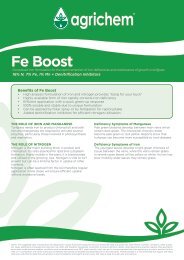Amino Feed N - PIS_AUS.pdf - Agrichem
Amino Feed N - PIS_AUS.pdf - Agrichem
Amino Feed N - PIS_AUS.pdf - Agrichem
- No tags were found...
You also want an ePaper? Increase the reach of your titles
YUMPU automatically turns print PDFs into web optimized ePapers that Google loves.
<strong>Amino</strong> <strong>Feed</strong> NTotal <strong>Amino</strong> Acids 40%Benefits of <strong>Amino</strong> <strong>Feed</strong> N• Organic nitrogen derived predominantly from protein hydrolysis of plant material, free ofnitrate form long and short term effective uptake and utilization in crops and turf grass• Contains highly available amino acids to satisfy the crop demand• Ideal for foliar and soil applications with rapid rainfast properties on foliage• Watering-in required to push it into the root zone after application in crops using boom oroverhead sprinklers• The key amino acid favour chlorophyll and protein synthesis• A brown free flowing liquid that eliminates nitrogen deficiency syndrome. BFA Certifiedorganic Nitrogen.THE IMPORTANCE OF AMINO ACIDS AND NITROGENMost organic growers apply organic nitrogen fertilizer to grow their crops to a specified standard. <strong>Amino</strong><strong>Feed</strong> N ishighly concentrated source of organic nitrogen, rich in amino acids to directly meet the nitrogen demand of the crop.It is a brown free flowing liquid derived from the controlled enzymatic hydrolysis of plant material by bacteria andfiltered to the micro fine particle size. The process does not alter the ratio of L-amino acid form, a highly availableform that is quickly recognised by the roots for rapid absorption. The L-amino acids are directly accepted by theprotein synthesis in plants to get processed by the plant cells into proteins, thereby, short-circuiting the nitrate toammonium step in the nitrogen metabolism. This step saves energy that is then redirected towards other metabolicprocesses to give the yield advantage. <strong>Amino</strong>feed N is a free flowing liquid formulation to replace relatively insolublesources of organic nitrogen and its high N content in its organic class satisfies the crop demand at critical stagesof growth. Nitrogen drives crop growth and is essential forl chlorophyll biosynthesis, photosynthesis and yield.<strong>Amino</strong><strong>Feed</strong> N is applied either through overhead sprinklers, drippers, centre pivots or through a boom spray followedwith irrigation to push it into the root zone. The application rates can be easily spread over the entire crop durationto derive the maximum nitrogen use efficiency. The rates would depend upon the N demand of the crop during theseason.NOTE: The suggested rates of application are designed for typical Australian conditions and such should be used as a guide only. Each farmer’s climatic conditions, water quality,soil types, application processes and practices may differ and therefore necessitate corrections to ensure optimum results. Good agricultural practice requires that applicationbe avoided under extreme weather conditions such as temperatures over 28 o C, high humidity, frost, rain etc. It is recommended that when applying to a crop or area for the firsttime, or in combination with other chemicals, a small test area should be sprayed and observed prior to the total spray. Where possible, it is recommended that regular leaf (sap)tests are conducted to determine actual plant nutrient availability during each growth cycle. Soil tests at least once per year are essential.
Product CharacteristicsSpecific Gravity: 1.13 - 1.17 Colour: BrownAnalysis Australia (w/v%) International (w/w%)Nitrogen (N) 7.0 6.1Total <strong>Amino</strong> Acids 40.0 34.0Directions for UseAgitate contents well before dilution. Suitable for application by:Foliar Spray Fertigation Boom Spray Centre PivotCROPRate/haMINDILUTIONALMONDS- Foliar 1.5 - 2 L 1 : 150APPLES- Foliar 2 - 3 L 1 : 100AVOCADOS- Foliar 2 - 3 L 1 : 150BROADACRE- FoliarCanola, GrainLegumes, Maize,Triticale Lupins &Wheat7 - 10 L5 - 6 L1 : 201 : 30COMMENTSApply to recently hardened spring flush or during active growingperiod and post harvestApply to newly hardened spring flush or during active growingperiod and post harvestApply to recently hardened spring flush or during active growingperiod and post harvestBest applied at the mid-late cabbage stage in canola.Apply 3 - 5 leaf stage and repeat, if requiredCITRUS- Fertigation 2 - 4 L 1 : 100 Apply every flush and during the active growing period and postharvest.NUT CROPS- Foliar- FertigationSTONE FRUIT- FertigationVEGETABLES- Foliar- FertigationVINES- Foliar- Fertigation2.0 - 2.5 L10 - 15 L3 - 5 L10 - 20 L2 - 4 L10 - 15 L2 - 4 L10 - 15 L1 : 150 Apply at early stages of growing season when sufficient leaf coverpresent. Apply with compatible crop protection sprays1 : 50 DO NOT SPRAY ON THE FOLIAGE. Best applied through soil1 : 50 Apply as requiredApply regularly in place of ammonium sulphate or urea1 : 100 First application: shoots 10 cm long. Second application: 5%flowering. For foliar spray do not use at concentrations less than1 : 50Minimum Dilution: A dilution of 1 : 100 means 1 part product : 100 parts waterIn hot weather, use the higher dilution rate where applicable<strong>Agrichem</strong> Head Office: 2 Hovey Road, Yatala QLD 4207, AustraliaPh: +61 7 3451 0000 Fax: +61 7 3451 0093 Free Call: 1800 65 47 58Email: enquiries@agrichem.com.au Web: www.agrichem.com.au
















